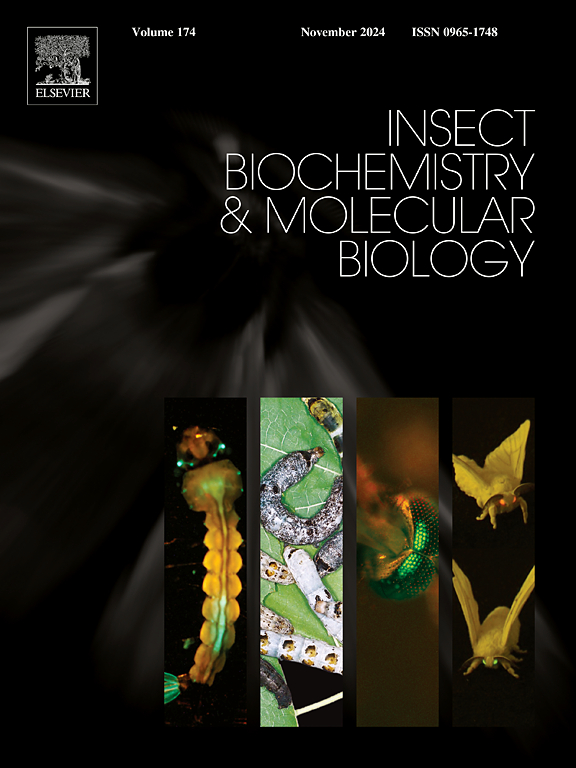Role of the clock gene period in regulating circadian rhythm of courtship vibrations in Nilaparvata lugens
IF 3.2
2区 农林科学
Q2 BIOCHEMISTRY & MOLECULAR BIOLOGY
引用次数: 0
Abstract
Nilaparvata lugens, the brown planthopper (BPH), is a notorious pest threatening rice production across Asia. The heavy reliance on synthetic insecticides for control has led to resistance and raised ecological concerns. Substrate-borne vibrational communication, integral to species-specific mate recognition systems in insects, presents a potential avenue for pest management through mating disruption. However, the molecular mechanisms regulating vibrational signals in BPH remain poorly understood. In this study, we cloned and analyzed the clock gene period from BPH. The open reading frame of Nlper is 3708 bp, encoding a 1235-amino acid protein with two conserved domains: the Per-ARNT-Sim domain and the Period protein 2/3C-terminal region. It shares a closer evolutionary relationship with Laodelphax striatellus and Frankliniella occidentalis. Spatiotemporal expression analysis showed that Nlper was consistently expressed across all life stages and adult tissues, with the highest levels in macropterous males and male head, respectively. Rhythmic expression exhibited significant circadian oscillations under both light-dark and constant darkness conditions, peaking at 00:00 and reaching a trough at 12:00, with fold changes ranging from 2.47 to 3.39. Moreover, after dsRNA injection, Nlper expression decreased by 77.21%–84.26% from day 2 to day 5, disrupting the circadian oscillation of female vibrational signals (FVS) and causing a significant peak shift, along with a 30.56% reduction in FVS frequency on day 5. These findings underscore the essential role of Nlper in regulating the circadian rhythm of courtship vibrational signals, deepening our understanding of the genetic basis of insect communication and opening new possibilities for innovative pest management approaches.

时钟基因周期在调节 Nilaparvata lugens 求偶振动昼夜节律中的作用。
褐飞虱(Nilaparvata lugens,简称BPH)是威胁整个亚洲水稻生产的臭名昭著的害虫。对合成杀虫剂的严重依赖导致了抗药性,并引起了生态问题。基材传播的振动通信是昆虫物种特异性配偶识别系统的组成部分,通过交配中断提供了害虫管理的潜在途径。然而,BPH中调节振动信号的分子机制仍然知之甚少。在本研究中,我们克隆并分析了BPH的时钟基因周期。Nlper的开放阅读框长度为3708 bp,编码一个1235个氨基酸的蛋白,具有两个保守结构域:Per-ARNT-Sim结构域和Period蛋白2/ 3c末端区。它与ladelphax striatellus和Frankliniella occidentalis有着更密切的进化关系。Nlper基因的时空表达分析表明,Nlper基因在所有生命阶段和成体组织中均有一致的表达,其中在成年雄鱼和雄鱼头部的表达水平最高。在光照-黑暗和恒定黑暗条件下,节律表达均表现出明显的昼夜振荡,在00:00达到峰值,在12:00达到低谷,倍数变化范围为2.47 ~ 3.39。此外,注射dsRNA后,Nlper的表达从第2天到第5天下降了77.21% ~ 84.26%,破坏了雌性振动信号(FVS)的日频振荡,引起了明显的峰移,第5天FVS频率降低了30.56%。这些发现强调了Nlper在调节求偶振动信号昼夜节律中的重要作用,加深了我们对昆虫交流遗传基础的理解,并为创新害虫管理方法开辟了新的可能性。
本文章由计算机程序翻译,如有差异,请以英文原文为准。
求助全文
约1分钟内获得全文
求助全文
来源期刊
CiteScore
7.40
自引率
5.30%
发文量
105
审稿时长
40 days
期刊介绍:
This international journal publishes original contributions and mini-reviews in the fields of insect biochemistry and insect molecular biology. Main areas of interest are neurochemistry, hormone and pheromone biochemistry, enzymes and metabolism, hormone action and gene regulation, gene characterization and structure, pharmacology, immunology and cell and tissue culture. Papers on the biochemistry and molecular biology of other groups of arthropods are published if of general interest to the readership. Technique papers will be considered for publication if they significantly advance the field of insect biochemistry and molecular biology in the opinion of the Editors and Editorial Board.

 求助内容:
求助内容: 应助结果提醒方式:
应助结果提醒方式:


